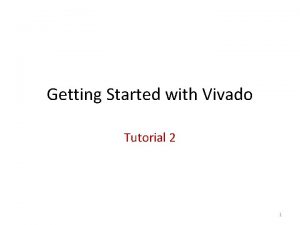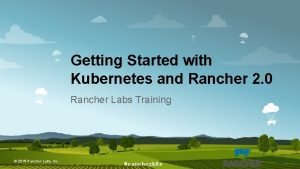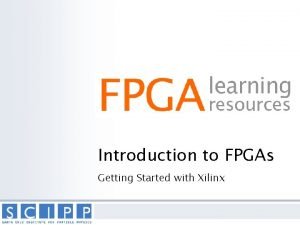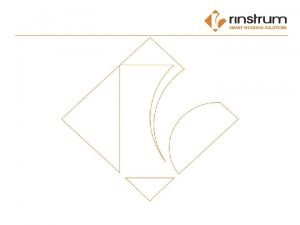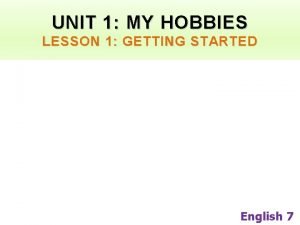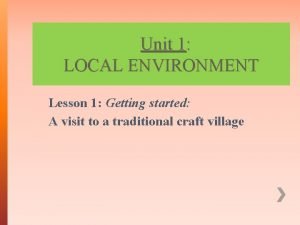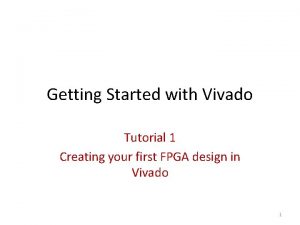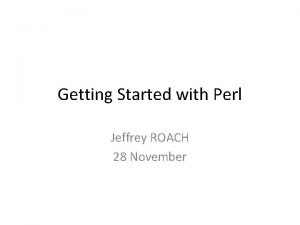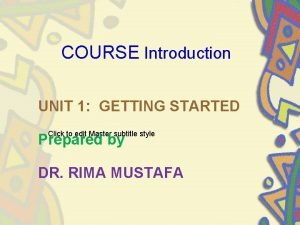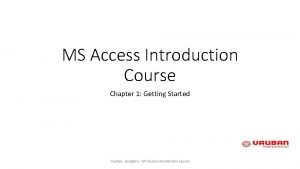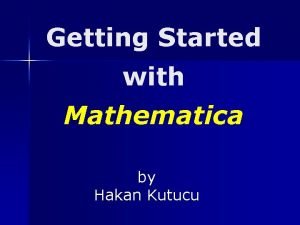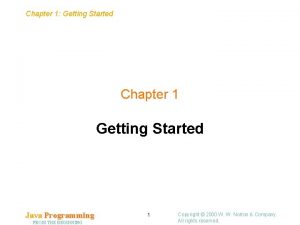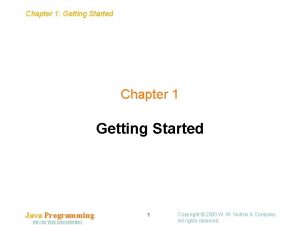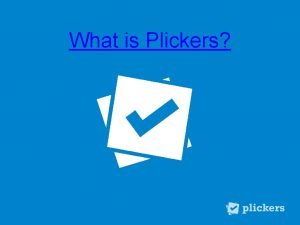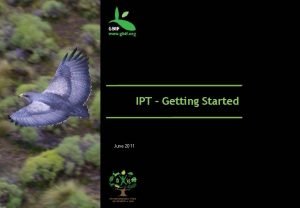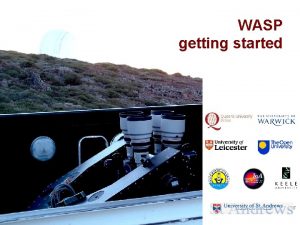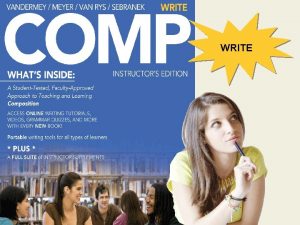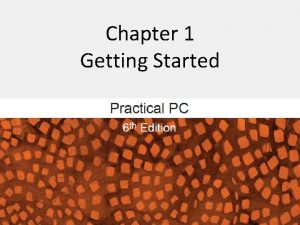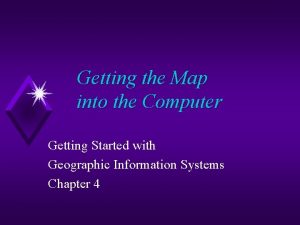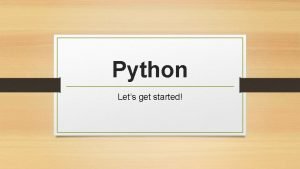Lecture 1 Getting Started Programming Computer programming is



![Programming Human [natural Computer [machine language]: 00111000110010111111001… @$#&*O&^%*$Q)E*R… programming language Programming Human [natural Computer [machine language]: 00111000110010111111001… @$#&*O&^%*$Q)E*R… programming language](https://slidetodoc.com/presentation_image_h/17a10df571045898c4b9c32000b8c370/image-4.jpg)

















![Flow of control: loops [Problem] Hint: Flow of control: loops [Problem] Hint:](https://slidetodoc.com/presentation_image_h/17a10df571045898c4b9c32000b8c370/image-22.jpg)











- Slides: 33

Lecture 1 Getting Started

Programming Computer programming is the process of designing and building an executable computer program for accomplishing a specific computing task.

Programming User: Computer: I want some music. . . I have i. Tunes installed… Programmer: I made i. Tunes… The process of designing and building i. Tunes for playing mp 3 music files is an example of programming.
![Programming Human natural Computer machine language 00111000110010111111001 OQER programming language Programming Human [natural Computer [machine language]: 00111000110010111111001… @$#&*O&^%*$Q)E*R… programming language](https://slidetodoc.com/presentation_image_h/17a10df571045898c4b9c32000b8c370/image-4.jpg)
Programming Human [natural Computer [machine language]: 00111000110010111111001… @$#&*O&^%*$Q)E*R… programming language

Programming language • There are many programming languages. • C++ is one of the most popular programming languages. • C++ is NOT the easiest programming language. • C++ is a middle-level programming language. • Mastering C++ can help you learn other programming languages faster.

Programming 源代码/源文件 The steps of building an executable program using C++ 目标代码/目标文件 编译器 可执行程序 连接器 库 Image source: http: //www. math. bas. bg/~nkirov/2004/Horstman/ch 01. html. Obtained: Sept 19, 2018.

A simple C++ program Let’s try! Compile g++ -c -o simple. cpp int main( ) { return 0; } Link g++ simple. o -o simple Execute Source file: simple. cpp . /simple Tested on mac. OS [Sept 19, 2018]

A simple C++ program Every C++ program contains one or more functions, one of which must be named main. int main( ) { return 0; } Source file: simple. cpp • Function name 函数名 • A list of parameters 参数列表 • Return type 返回类型 • Function body 函数体

A simple C++ program Compiles simple. cpp into simple. o. -c: compile -o simple. o: indicate the object file int main( ) { return 0; Compile g++ -c -o simple. cpp } • g++ is part of the GNU Compiler Collection (GCC). Source file: simple. cpp • g++ is a C++ compiler.

A simple C++ program Make simple. o into simple. -o simple: indicate the executable file ? ? ? ? ? ? ? Object file: simple. o Link g++ simple. o -o simple

“Hello, World!” Compile g++ -c -o hello. cpp #include <iostream> int main( ) { std: : cout << “Hello, World!n”; Link g++ hello. o -o hello return 0; } Execute Source file: hello. cpp . /hello Tested on mac. OS [Sept 20, 2018]

“Hello World!” preprocessor directives 预处理指令 header 头文件 #include <iostream> int main( ) { new line 换行符 std: : cout << “Hello, World!n”; standard cout 标准输出流 return 0; } insertion operator 流插入运算符 / 输出运算符

Sum of three integers #include <iostream> extraction operator 流提取运算符 / 输入运算符 int main( ) { 变量声明 int a, b, c; std: : cout << “Input 3 integers: n”; standard cin 标准输入流 std: : cin >> a >> b >> c; std: : cout << a + b + c << std: : endl; return 0; } Tested on mac. OS [Sept 20, 2018]

Sum of three integers #include <iostream> 标准命名空间 using namespace std; int main( ) { int a, b, c; cout << “Input 3 integers: n”; cin >> a >> b >> c; cout << a + b + c << endl; return 0; } Tested on mac. OS [Sept 20, 2018]

Recall The steps of building an executable program using C++ hello. cpp g++ -c -o hello. cpp hello. o hello g++ hello. o -o hello Image source: http: //www. math. bas. bg/~nkirov/2004/Horstman/ch 01. html. Obtained: Sept 19, 2018.

IDE Integrated Development Environment, 集成开发环境 An IDE is a software application that provides comprehensive facilities to computer programmers for software development. • Source code editor • Build automation tools • Debugger

IDE Microsoft Visual Studio Dev-C++ Eclipse Sublime Text

Comments 注释 Comments help the human readers, including the programmer himself, to understand the code. • Summarize an algorithm • Explain the functionality of a function • Identify the purpose of a variable • Clarify an otherwise obscure segment of code

Comments #include <iostream> /* * An example main function: * Read in 3 integers and print their sum. */ int main( ) { // TODO implement later… return 0; }

Comments help the human readers, including the programmer himself, to understand the code. • Compilers ignores comments. • In practice, it is very important to make your codes readable and maintainable.

Flow of control #include <iostream> using namespace std; int main( ) { int a, b, c; cout << “Input 3 integers: n”; sequential execution cin >> a >> b >> c; cout << a + b + c << endl; return 0; }
![Flow of control loops Problem Hint Flow of control: loops [Problem] Hint:](https://slidetodoc.com/presentation_image_h/17a10df571045898c4b9c32000b8c370/image-22.jpg)
Flow of control: loops [Problem] Hint:

Flow of control: loops Repeat

Flow of control: loops #include <iostream> int main( ) { 条件 int s = 0, i = 1, n; // TODO Get n from user input. while语句 while ( i <= n ) { s += i; ++i; } std: : cout << std: : endl; 循环体 +=: compound assignment operator ++: (prefix) increment operator return 0; } Tested on mac. OS [Sept 20, 2018]

Flow of control: loops #include <iostream> 循环头:初始化; 条件; 表达式 int main( ) { int s = 0, n; // TODO Get n from user input. for语句 for (int i =1; i <= n; ++i ) { s += i; } 循环体 std: : cout << std: : endl; return 0; } Tested on mac. OS [Sept 20, 2018]

Data structures & classes WALL·E move_north( ) move_south( ) move_east( ) move_west( ) (x, y)

Data structures & classes class Robot { WALL·E public: int move_north( ); move_north( ) move_south( ) move_east( ) move_west( ) (x, y) int move_south( ); int move_east( ); int move_west( ); // TODO Other skills: pick, fire, … private: int x; int y; // TODO Other data };

Data structures & classes WALL·E move_north( ) move_south( ) move_east( ) move_west( ) (x, y) A data structure is a data organization, management and storage format that enables efficient access and modification. In C++, we implement a data structure by defining a class. An instance of a class is called an object.

OOP Object-Oriented Programming, 面向对象程序设计 The object-oriented worldviews the world as a collection of objects and their interactions. An object oriented program is structured as a community of interacting objects. Each object has a role to play. Each object provides a service, or performs an action, that is used by other members of the community. Timothy Budd, Introduction to Object-Oriented Programming, 3 rd edition, Addison-Wesley, 2002.

OOP • A fundamental concept in object-oriented programming is to describe behavior in terms of responsibilities. • By discussing a problem in terms of responsibilities we increase the level of abstraction. • This permits greater independence between objects, a critical factor in solving complex problems. Timothy Budd, Introduction to Object-Oriented Programming, 3 rd edition, Addison-Wesley, 2002.

OOP Robot walle; Robot eve; walle. move_north( ); eve. move_west( );


Next lecture • C++ Primer, Chapters 2 & 3. 1 -3. 2
 The secret of getting ahead is getting started
The secret of getting ahead is getting started Getting started with vivado
Getting started with vivado Getting started with unix
Getting started with unix Education splunk
Education splunk Rancher slack
Rancher slack Getting started with excel
Getting started with excel Getting started with microsoft outlook learning
Getting started with microsoft outlook learning Getting started with xilinx fpga
Getting started with xilinx fpga Getting started with lua
Getting started with lua When does elena receive dolls from her family members
When does elena receive dolls from her family members Unit 1 getting started
Unit 1 getting started Find these things in unit 1
Find these things in unit 1 Infuecers gone wild
Infuecers gone wild Hi3ms
Hi3ms Perl read_file
Perl read_file Getting started with ft8
Getting started with ft8 Listen and read unit 3
Listen and read unit 3 Unit 1 getting started
Unit 1 getting started Getting started with poll everywhere
Getting started with poll everywhere Android development getting started
Android development getting started Getting started with access
Getting started with access Getting started with eclipse
Getting started with eclipse Mathematica getting started
Mathematica getting started 01:640:244 lecture notes - lecture 15: plat, idah, farad
01:640:244 lecture notes - lecture 15: plat, idah, farad C programming lecture
C programming lecture Computer security 161 cryptocurrency lecture
Computer security 161 cryptocurrency lecture Computer-aided drug design lecture notes
Computer-aided drug design lecture notes Architecture lecture notes
Architecture lecture notes Isa computer architecture
Isa computer architecture When was globalization started
When was globalization started What was urdu hindi controversy
What was urdu hindi controversy Khalid al dossary
Khalid al dossary Continuing professional development (cpd) act of 2016
Continuing professional development (cpd) act of 2016 Samaritan's purse founders
Samaritan's purse founders

